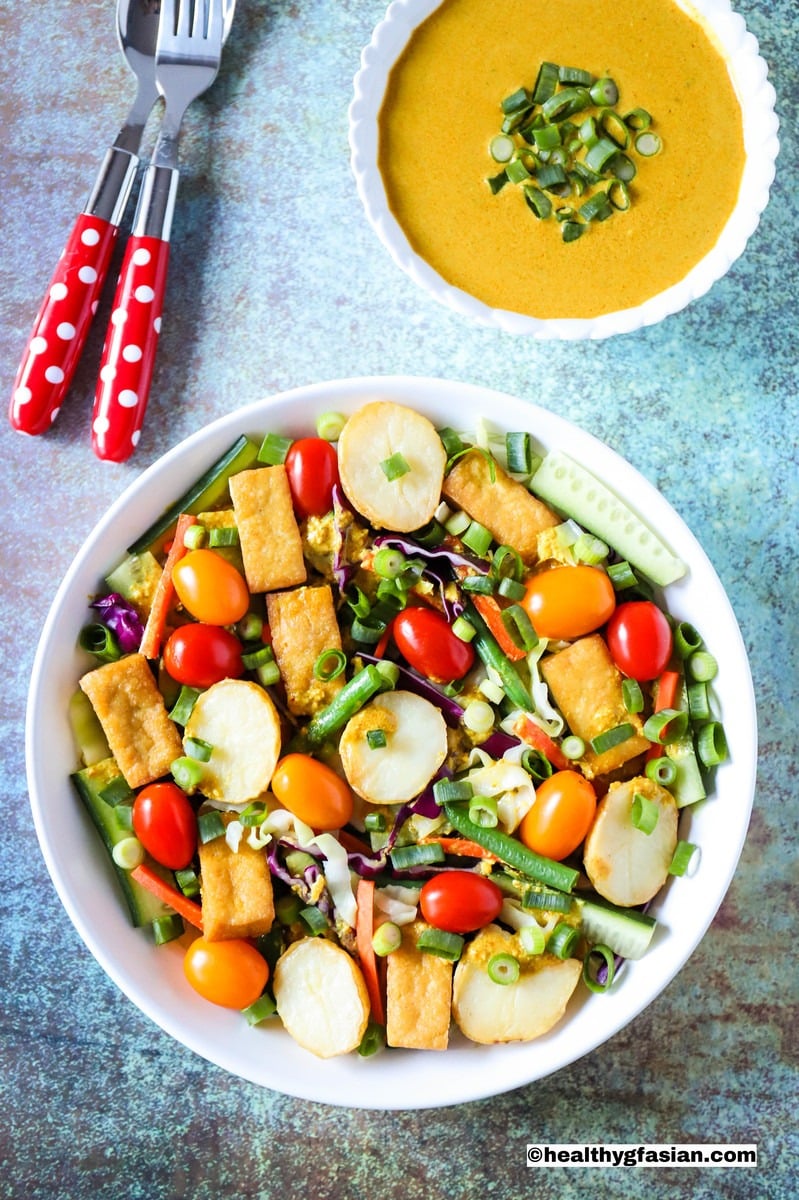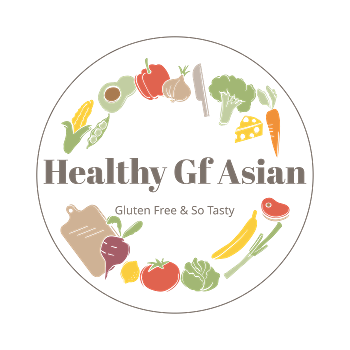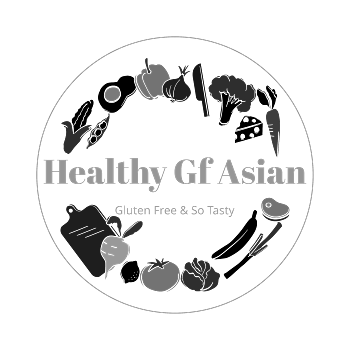Gado Gado Salad is a mixed vegetable Indonesian-style salad. Besides, they serve gado gado salad with peanut sauce dressing. It is also one of the top 5 national dish of Indonesia. In Indonesian language, the word gado gado means “mix-mix”, medley or potpourri. Likewise, they usually lightly steame, blanch or boil the vegetables to preserve the freshness, colour and crunch.
Gado Gado Salad Ingredients
Typically, types of vegetables used for gado gado salad are cabbage, bean sprouts, fresh lettuce, and fresh cucumber. Also water spinach (Kang Kong), green beans, spinach, bitter melon, cauliflower, watercress, carrots, and fresh tomatoes. Moreover, lontong (rice cakes wrapped in banana leaf), fried or boiled potatoes, fried tofu, and fried tempeh. They are additional vegan accompaniments for gado gado salad. While vegetarian version normally includes hard boiled eggs.
Indonesian gado gado salad is very filling with all the extra accompaniments added. We normally consume gado gado salad as a main dish because it is quite a substantial serving. Although, garnish can include fish or prawn crackers and fried onion shallots. For modern types of gado gado, we also add red cabbage, capsicums, asparagus, zucchini, sweet potatoes or pumpkins. And some rice crackers as well. Basically, we can add any of your favourite vegetables to the dish.
Furthermore, we prepare the old style peanut sauce with fried mashed peanuts. As well as adding palm sugar, garlic, chilli, salt, tamarind and some lime juice. Sometimes we add cashew nuts to create a milder and light sauce.
Gluten Free Gado Gado Salad with Nut Free Sauce
For my gluten free gado gado salad recipe, I used a medley of vegetables. Specifically, they are green bean, cabbage, red cabbage, cucumber, carrots, small red and golden gourmet tomatoes. Together with baked potatoes and fried tofu. As a result, we get a tasty, nutritious, attractive and vibrant dish. Gado gado salad is a perfect dish or side dish for entertaining at home to impress your friends and family.
For my nut free gado gado salad sauce, my ingredients are mainly seeds as substitute for peanuts. Nonetheless, they include sunflower seeds, and pepitas seeds (pumpkin seeds). In addition, my other ingredients are sweet chilli sauce, coconut milk, coconut sugar, ginger and garlic. Then, mixed with spices like turmeric powder, paprika powder, cumin powder and coriander powder. Equally, the gado gado salad sauce is creamy and full of flavour. You will not even notice that it is nut free.
This gado gado salad recipe is not only naturally gluten free. But also vegan, dairy free, egg free, nut free and refined sugar free. For soy free, simply omit the fried tofu and add some pumpkin for protein.
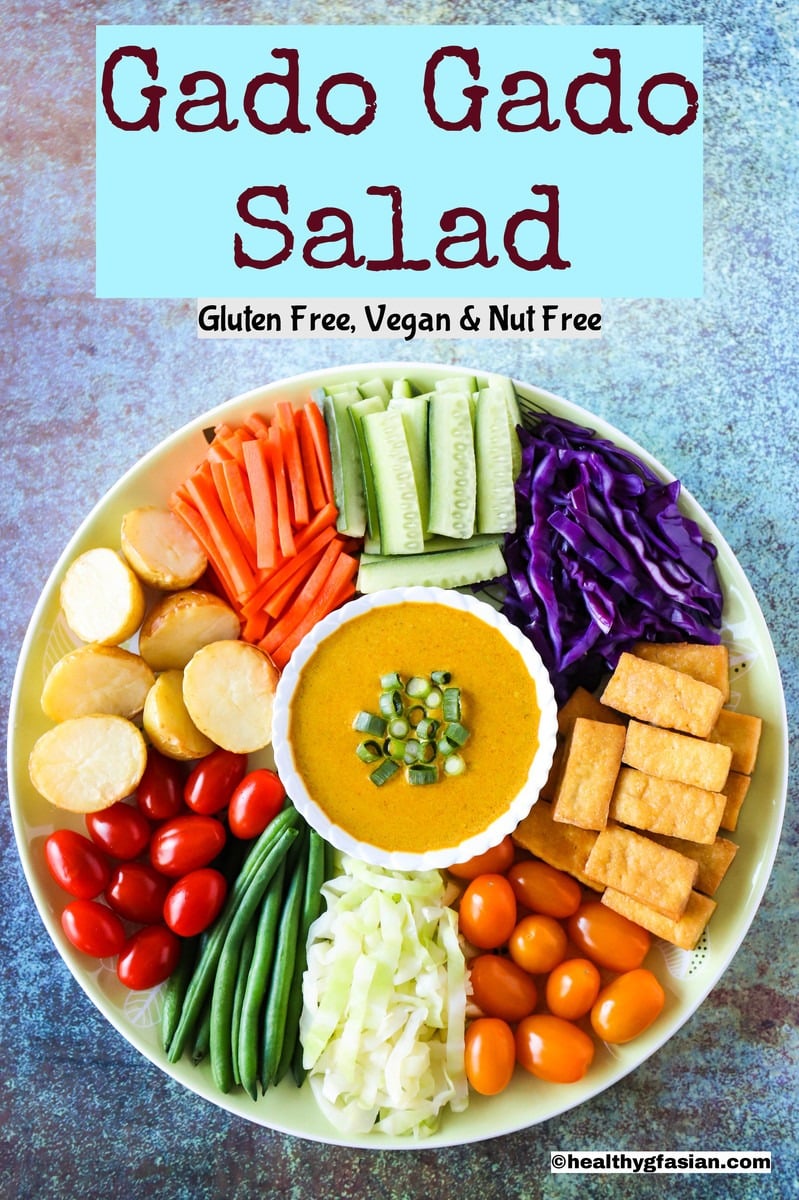
History of Gado Gado Salad
Immigrants from other parts of Asia and Indonesia created gado gado salad dish in Batavia (a former name of Jakarta). In addition, slaves brought here by the Dutch and English spice traders during the 17th century. And they also created their own version of gado gado salad. Besides, they are the original inhabitants of Batavia and started calling themselves people of Betawi in the 19th century. The Betawi population refer gado gado salad as a delicious, healthy and affordable dish.
Traditionally, gado gado salad Betawi is a street food. While today it is available on mobile food carts, in food courts of shopping malls. Plus cafes, restaurants and even five star hotels. On the whole, many people eat gado gado salad all over Indonesia and worldwide with local versions.
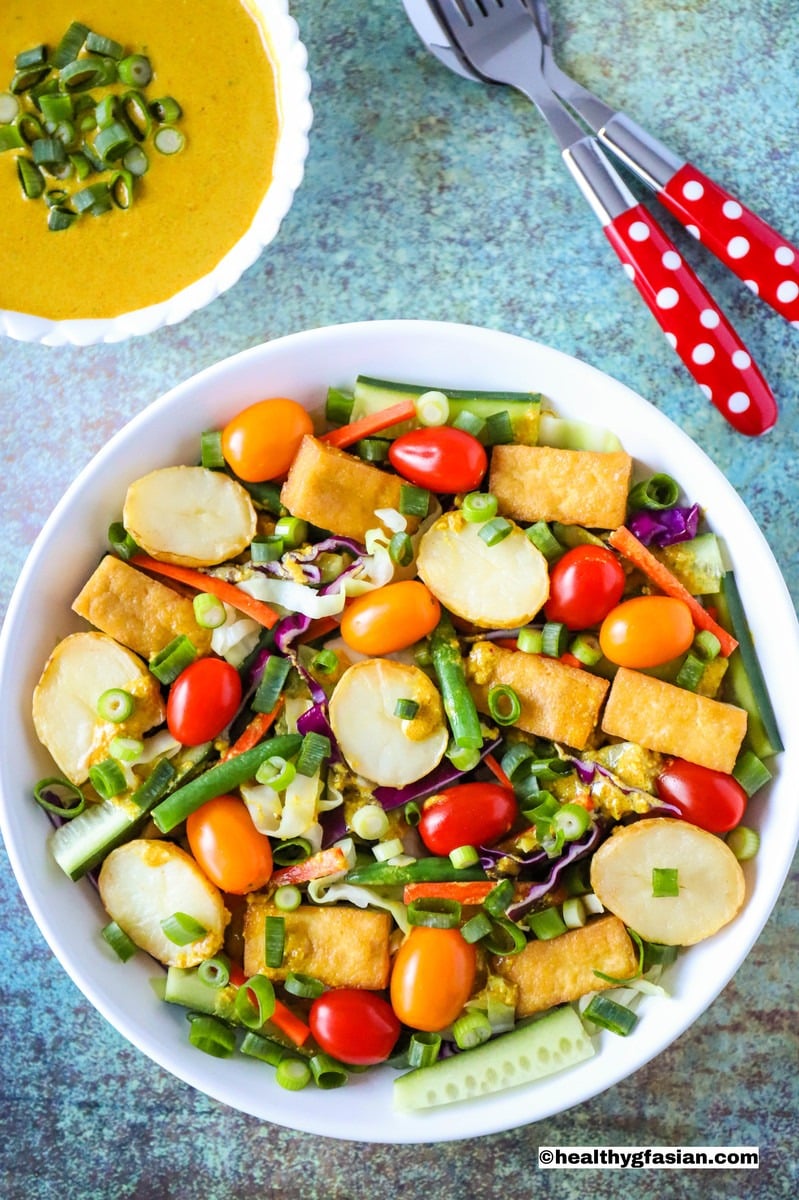
Nutritional Values and Health Benefits of Gado Gado Salad
Carrot
The carrot (Daucus carota) is a root vegetable that belongs to the Apiaceae or Umbelliferae family. We have been eating carrots as a food crop for more than 5,000 years. Carrots originated from Asia, Europe and Africa. It is usually orange in colour, but they are also available in black, purple, red, yellow and white.
Nutritional Values of Carrot
Our mothers always tell us that carrots are “good for your eyes” on the dining table. This is because carrots are especially rich in beta carotene and alpha carotene. They are antioxidants which your body will convert to vitamin A. In addition, they are also a good source of dietary fiber, potassium and other antioxidants like lutein and zeaxanthin. As well as vitamin B6 (pyridoxine), vitamin B8 or H (Biotin), vitamin C, and vitamin K.
Health Benefits of Carrot
The many health benefits of carrots may comprise:
- Support healthy eyesight;
- Lower cholesterol level;
- Regulate blood pressure;
- Reduce risks of cardiovascular diseases;
- Lower risks of cancer mainly leukemia, prostate, colon, stomach and breasts;
- Boost the immune system;
- Promote strong teeth and bones;
- Help cleanse and remove toxins from the liver;
- Promote skin health;
- Detoxify the liver; and
- Aids in the treatment of diabetes.
Cucumber
Cucumber (Cucumis sativus) plant belongs to the gourd family named Cucurbitaceae. It originated from South Asia and now grown all over the world.
Nutritional Values of Cucumber
Cucumber is a very low in calorie, carbohydrate, sodium, dietary fiber and protein and has nearly zero fats. But it is very high in vitamin K and has 95% of water content. Cucumber is also a good source of Vitamin C and Potassium.
In addition, it has fairly good amount of vitamin A, vitamin B5 (pantothenic acid), magnesium, manganese and phosphorus. Furthermore, cucumber has several antioxidants, including flavonoids, triterpenes, lignans, and cucurbitacins, which have anti-inflammatory and anti-cancer properties.
Health Benefits of Cucumber
The overall Health benefits of cucumber may include:
- Supports hydration for the body;
- Maintains healthy blood pressure and lower risks of cardiovascular diseases;
- Promotes healthy skin;
- Supports healthy bones;
- Assists in the management of diabetes;
- Aids in weight management;
- Helps combat inflammation in the body;
- Improves digestive health and prevents constipation;
- Reduces the risks of cancer;
- Enhances memory; and
- Reduces the risks of Alzheimer’s disease or dementia.
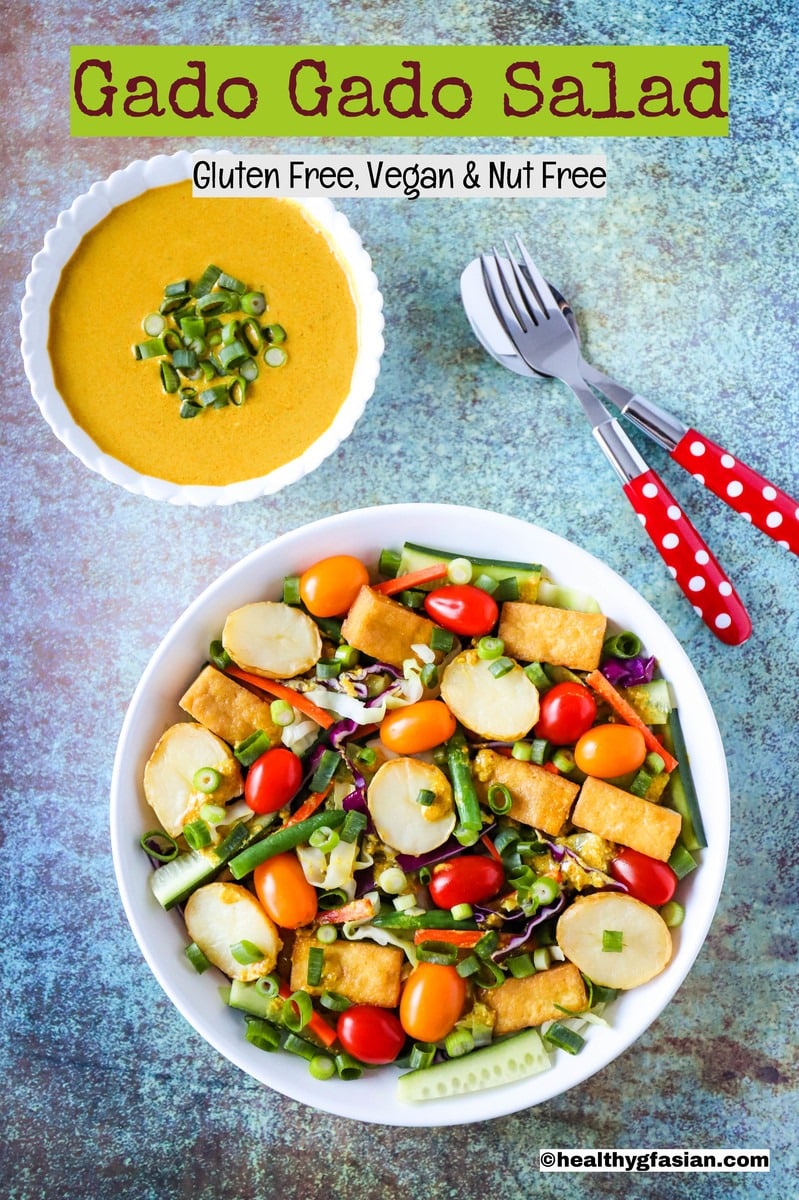
Green Bean
The beloved green bean is the immature edible pods of the common bean (Phaseolus vulgaris). Moreover, it belongs to the leguminous plant of the Fabaceae family. Additionally, other common names for green bean are French beans, string beans, snap beans and snaps. Green bean originated in Central and South America. Similarly, they grew green bean for many thousands of years in Mexico and Peru. Today, they grow and eat them worldwide.
Nutritional Values of Green Bean
Green beans are high in dietary fiber, low in calorie and contain protein. They are an excellent source of vitamin A, C and K. And also a good source of vitamin B1 (thiamine), vitamin B2 (riboflavin), folate, iron and manganese. Green beans also have some amounts of magnesium, potassium, phosphorus and calcium.
Health Benefits of Green Bean
The many health benefits of green beans may consist of:
- Reduce risks of cardiovascular diseases;
- Promote healthy eyesight;
- Lower risks of colon cancer;
- Help manage diabetes;
- Enhance bone health and prevent osteoporosis;
- Increase fertility and manage pregnancy;
- Treatment of anaemia;
- Support wound healing;
- Boost the immune system;
- Defend against free radical damage; and
- Detoxify the body with its potent diuretic properties.
Potato
Originally, they grew the humble potato or spud in Peru for many thousands of years ago. Dated all the way back around 8,000 BC to 5,000 BC. Eventually, in 1536, the Spanish victors of Peru brought potatoes back to Europe. Potato is a root vegetable, specifically the edible starchy tuber section of the Solanum tuberosum plant. Moreover, potato belongs to the Solanaceae or nightshades family.
Potato originated from both the North and South America. Besides, they grew potato around 7,000 to 10,000 years ago. Today, they rank potato fourth as one of the world’s biggest and most important food crop. Ranking just behind maize (corn), wheat and rice. Potatoes are now an important everyday food staple in our diet.
Overall, the variety of potato, its origin, processing and cooking technique can all influence their nutritional values. Choose healthy cooking methods like steam, boil, bake, oven roasted or even stir frying. As well as using healthy oils like olive oil. Furthermore, exclude heavy and too much topping like ghee, butter, sour cream, cheese and salt. Always remember to eat a balanced diet. Together with potatoes that are high in nutrients, can be beneficial for you.
Nutritional Values of Potato
Potatoes has 70%-80% water, complex carbohydrates (only 9% of the recommended daily value). Likewise, it has modest amount of dietary fiber and protein with almost zero fats. As well as sodium free and cholesterol free. In addition, the protein in potatoes include lysine, an essential amino acid usually lacking in vegetable protein. Potatoes are an excellent source of vitamin C (nearly half of your daily value). Plus a good source of potassium (more than a banana) and vitamin B6.
In addition, potatoes are high in bioactive plant compounds, primarily focused in the skin. The key polyphenol, a type of antioxidant present in potatoes is chlorogenic acid. Followed by catechin, an antioxidant that is around 1/3 of the total polyphenol content and lutein, a carotenoid antioxidant.
Health Benefits of Potato
All in all, the health benefits of potatoes may include:
- Provide a significant source of energy from their complex carbohydrates;
- Help lower blood pressure;
- Reduce risks of cardiovascular diseases;
- Aids in weight management as potatoes help make you feel fuller for longer;
- Reduce inflammation for the digestive system, gout and rheumatism arthritis;
- Neutralize the damaging effects of “free radicals”;
- Help regulate metabolism;
- Promote healthy gums and treat scurvy;
- Support healthy central nervous system;
- Preclude development of kidney stones;
- Diminish signs of aging; and
- Aid in the treatment and healing of sprains, bruises, mouth ulcers and burns.
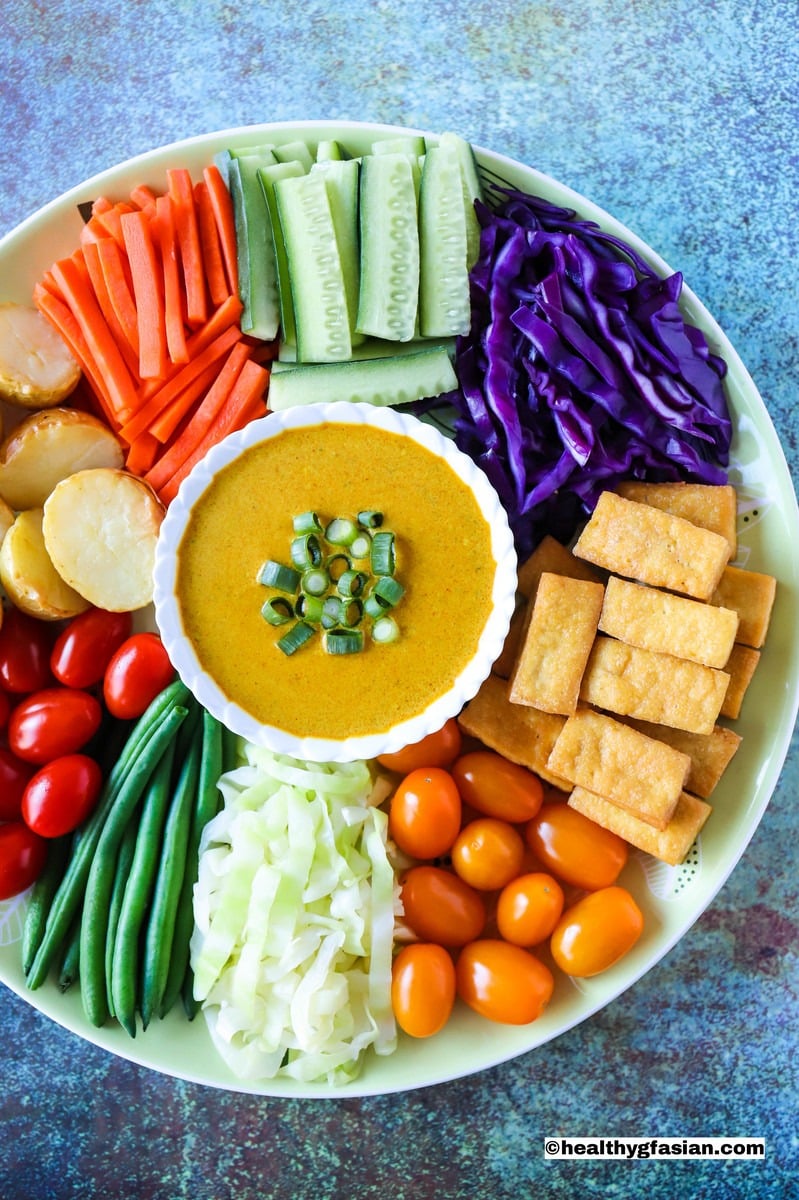
Cabbage
Cabbage (Brassica oleracea) is a leafy vegetable. And it belongs to the genus Brassica and the mustard family (Brassicaceae). Likewise, they grow cabbage on a yearly basis. Besides, it has 3 cultivars of leafy green, red or purple, or white (pale green). Furthermore, it is closely related to cauliflower, broccoli, kale and Brussels sprouts. All in all, these cruciferous vegetables came from the wild cabbage (Brassica oleracea). Cabbage was first grown in Europe around 1,000 BC. Mainly in Western Europe and around 4,000 BC in the East in North China.
Nutritional Values of Cabbage
Cabbage is rich in dietary fiber and low in calorie. It is also an excellent source of vitamin K and vitamin C. As well as a good source of folate (vitamin B9), vitamin B6 (pyridoxine) and manganese. Cabbage has antioxidants namely choline, beta-carotene, lutein and zeaxanthin as well as flavonoids like apigenin, quercetin and kaempferol. Red cabbage are richer in these antioxidants and flavonoids than white or green cabbage.
Red or purple cabbage has a special flavonoids called anthocyanins, giving it its colour. Moreover, the colour of cabbage is based on how much anthocyanin it has. The higher the amount of anthocyanin levels, the darker it appears. Likewise, red cabbage has less calorie, less vitamin K and folate (vitamin B9). But much more vitamin C than white or green cabbage. Similarly, the red or purple cabbage has anthocyanin that help improves brain health. These plant phytonutrients help defend the body against chronic pain and inflammation and oxidative stress.
Health Benefits of Cabbage
The wide ranging health benefits of cabbage may consist of:
- Boost the immune system;
- Lower risks of cardiovascular disease;
- Reduce risks of inflammatory diseases like osteoporosis, arthritis and rheumatism;
- Support healthy skin;
- Aid in weight loss;
- May help protect against radiation;
- Decrease risks of cancers of the colon, lungs and breasts;
- Ease symptoms of intestinal ulcers;
- Improve digestive health;
- Decrease risks of diabetes;
- Lower risks of Alzheimer’s disease and dementia; and
- Reduce risks of cataracts and macular degeneration.
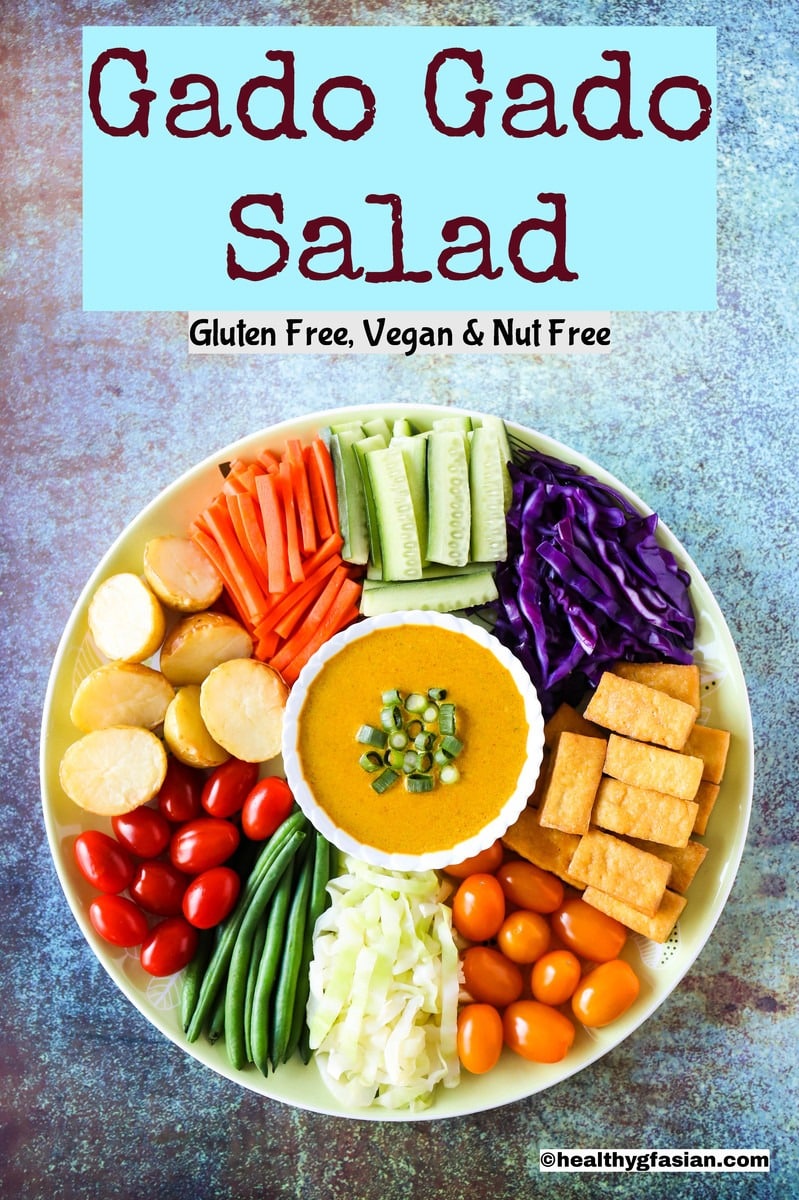
Tomato
Tomato is an edible berry of a tomato plant (Solanum lycopersicum). It belongs to the Solanaceae or nightshade family just like potatoes. Both tomato and cherry tomato were first cultivated in Mexico in the 15th century. They transported the first tomato to Europe during this time.
Grape Tomato Vs Cherry Tomato
Grape tomato originated from the Southeast Asian country of Taiwan. They are oblong fruits just like regular grapes, small in size and sweet tasting. They are also similar to the small rounded cherry shaped cherry tomato. Although slightly larger in size, crisp, sweeter and juicier in taste. Cherry tomato sizes range from thumb tip to golf ball size. But grape tomato are crunchy, meatier with thicker skin and less juicy. But they tend to keep well for longer than cherry tomato.
Grape tomato come in red, yellow, orange and brown colours. While cherry tomato come in red, yellow, orange and green varieties. Since grape tomato are tougher and less delicate to package and for hauling. They have increasingly gained more popularity than cherry tomato to grow and sell. However, they frequently use both grape and cherry tomato as a substitute for each other. Especially in recipes like salads, pizza, pasta, stew, cocktails, etc. Due to the larger size of cherry tomato, they are often a preferred choice when used for stuffing.
Nutritional Values of Tomato
The nutritional values and health benefits for both cherry and grape tomato are very similar. However, the components of essential vitamins and minerals can vary between different assortments and seasons. Tomatoes are 95% water, contain dietary fiber and are low in calorie and carbohydrates. They are also an excellent sauce of vitamin A, vitamin C, vitamin K and potassium.
Tomatoes are also a good source of vitamin B3 (niacin), vitamin B6 (pyridoxine), folate (vitamin B9), copper and manganese. All tomato are rich in plant antioxidant compounds. Additionally, It comprises lycopene, beta carotene, chlorogenic acid and flavonoid like naringenin (in tomato skin). Besides lycopene is a red pigment and carotenoid responsible for the red colour of tomato.
Research indicates that the processing and cooking of tomato can increase its nutritional values. Especially their antioxidant activities and lycopene compounds.
Health Benefits of Tomato
Largely, the health benefits of tomato may include:
- Lower blood pressure and risks of cardiovascular diseases;
- Decrease ‘bad” cholesterol (LDL);
- Prevent cancers like prostate, lungs, breasts and stomach;
- Promote healthy skin and hair;
- Aid in management of diabetes;
- Improve eye health;
- Support healthy bones;
- Decrease risks of kidney stones; and
- Support healthy digestive system.
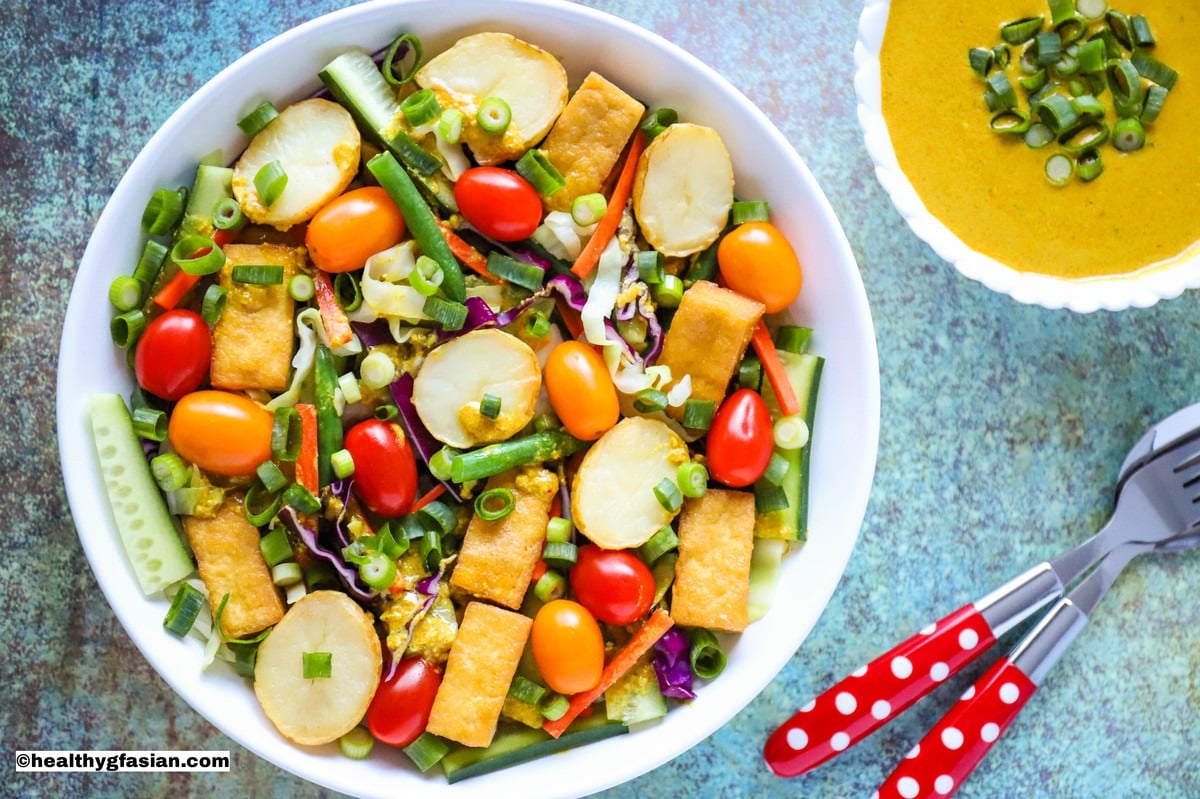
Tofu
Tofu or often referred to as bean curd originated from China for more than 2,000 years ago. A traditional food staple for many Asian cuisines especially Chinese and Japanese cuisines. They broadly savour tofu as food made from soya bean. Made by curdling fresh soya milk and compressing the curds into solid white blocks. Tofu has differing softness: silken, soft, firm, extra firm and hard.
Because tofu has a neutral flavour, they use it in a wide variety of dishes, sweet or savoury. In modern day, they sell various types of tofu in different seasonings and marinates. Tofu has a neutral taste, it can take on any flavours of a dish well. They use tofu as the most widely used soya product in the world. That is all natural, naturally gluten free, affordable and nutritious. They often use tofu as a meat substitute for vegetarians and vegan as an important source of protein for them.
Check out my other tofu recipes below:
Nutritional Values of Tofu
Tofu is a perfect source of plant protein as it has all the 9 essential amino acids. It is not only low in calorie and fats but cholesterol free as well. In addition, tofu is an exceptional source of calcium, manganese, copper, selenium, phosphorus and omega-3 fatty acids. Furthermore, tofu is a good source of iron, magnesium, zinc and vitamin B1 (thiamine). Tofu contains phytoestrogens named isoflavones. It has similar structure to the female hormone oestrogen. As a result, it imitate the action of oestrogen made by the body.
Health Benefits of Tofu
On the whole, health benefits of tofu may consist of:
- Reduce risks of cardiovascular diseases;
- Help lower levels of bad cholesterol (LDL);
- Promote strong bones and lower risks of osteoporosis;
- Reduce risks and also aid in the management of diabetes;
- Relief symptoms of menopause;
- Decrease risks of prostate, breasts and colon cancers;
- Promote healthy skin;
- Assist in weight loss management; and
- Support healthy brain functions and reduce risks of age-related brain diseases.

Ingredients
- 450 g organic hard tofu drained, halved and cut into 1 inch pieces
- 16 baby potatoes halved
- 2 medium Lebanese cucumber sliced and cut into thin sticks (fresh)
- 18 small red grape or cherry tomatoes
- 18 small gold grape or cherry tomatoes
- 200 g green beans (lightly blanched)
- 200 g white cabbage thinly sliced (lightly blanched)
- 200 g red cabbage thinly sliced (fresh for the crunch or lightly blanched)
- 2 medium carrots julienned (fresh)
For the Nut Free Sauce:
- ¼ cup extra virgin olive oil
- 90 g sunflower seeds
- 30 g pepitas seeds or pumpkin seeds
- 3 garlic cloves peeled and finely minced
- 1 inch ginger peeled and finely grated
- 1 teaspoon coriander seed powder
- 1½ teaspoon turmeric powder
- 1½ paprika powder
- ¼ teaspoon cumin powder
- ¼ cup sweet chilli sauce seedless
- 1 tablespoon lime juice
- 2 tablespoons coconut sugar
- 1 teaspoon salt
- 400 ml lite coconut milk
- 250 ml water
- 2 teaspoons potato starch mixed with ¼ cup (62.5ml) water
For the Garnish:
- 1 large spring onions (shallots) including the white parts, thinly sliced lengthwise
Instructions
For the nut free sauce:
- Add the sunflower seeds and Pepitas seeds into a food processor and process until fine.
- Heat up a frying pan with the extra virgin olive oil. Pan fry the garlic and ginger on low heat until lightly golden.
- Then add the ground seeds prepared in step 1, sweet chilli sauce, coriander powder, turmeric powder, paprika powder and cumin powder and mix and stir fry on low heat for 2 to 3 minutes.
- Add the coconut sugar, salt, lime juice, coconut milk, water and potato starch mixture and bring to a boil. Then simmer on low heat for 20 minutes. Set aside in a large bowl until ready to serve.
For the salad:
- Pre-heat fan force oven to 160C or 320F. Place all the potatoes evenly in a large baking tray lined with baking paper. Add salt and some extra virgin olive oil and rub and mix well. Bake in the oven for 30 mins or until just soft and golden brown. Set aside.
- Heat up a medium pot half-filled with water and bring to a boil. Lightly blanch separately the green beans and cabbage for 1 minute. Drained and set aside.
- Arrange the salad ingredients on a large plate by categories and serve with the sauce in the middle.
- Alternatively, you can toss and mix all the salad ingredients in a large bowl and drizzle with some sauce before serving plus extra sauce in a bowl by the side.
Recommended Products
Notes
